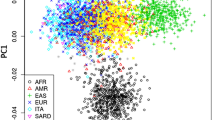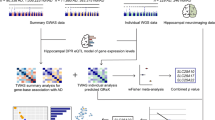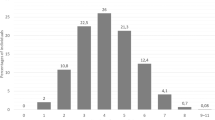Abstract
Many candidate gene studies use ‘intermediate phenotypes’ instead of disease diagnoses. It has been proposed that intermediate phenotypes have simpler genetic architectures such that individual alleles account for a larger percentage of trait variance. This implies that smaller samples can be used to identify genetic associations. Pharmacogenomic drug challenge studies may be an especially promising class of intermediate phenotype. We previously conducted a series of 12 candidate gene analyses of acute subjective and physiological responses to amphetamine in 99–162 healthy human volunteers (ADORA2A, SLC6A3, BDNF, SLC6A4, CSNK1E, SLC6A2, DRD2, FAAH, COMT, OPRM1). Here, we report our attempt to replicate these findings in over 200 additional participants ascertained using identical methodology. We were unable to replicate any of our previous findings. These results raise critical issues related to non-replication of candidate gene studies, such as power, sample size, multiple testing within and between studies, publication bias and the expectation that true allelic effect sizes are similar to those reported in genome-wide association studies. Many of these factors may have contributed to our failure to replicate our previous findings. Our results should instill caution in those considering similarly designed studies.
Similar content being viewed by others
Log in or create a free account to read this content
Gain free access to this article, as well as selected content from this journal and more on nature.com
or
References
Alexander RC, Wright R, Freed W (1996). Quantitative trait loci contributing to phencyclidine-induced and amphetamine-induced locomotor behavior in inbred mice. Neuropsychopharmacology 15: 484–490.
American Journal of Medical Genetics Part B: Neuropsychiatric Genetics. Editorial Policy on Association Studies http://onlinelibrary.wiley.com/journal/10.1002/(ISSN)1552-485X/homepage/ForAuthors.html.
Anonymous (2005). Framework for a fully powered risk engine. Nat Genet 37: 1153.
Barsh GS, Copenhaver GP, Gibson G, Williams SM (2012). Guidelines for genome-wide association studies. Plos Genet 8: e1002812.
Bennett C, Baird AA, Miller MB, Wolford GL (2011). Neural correlates of interspecies perspective taking in the post-Mortem Atlantic Salmon: an argument for proper multiple comparisons correction. J Serendipitous Unexpected Results 1: 1–5.
Benowitz NL, Pomerleau OF, Pomerleau CS, Jacob P (2003). Nicotine metabolite ratio as a predictor of cigarette consumption. Nicotine Tob Res 5: 621–624.
Bosker FJ, Hartman CA, Nolte IM, Prins BP, Terpstra P, Posthuma D et al (2011). Poor replication of candidate genes for major depressive disorder using genome-wide association data. Mol Psychiatry 16: 516–532.
Chait L, Fischman MW, Schuster CR (1985). 'Hangover' effects the morning after marijuana smoking. Drug Alcohol Depend 15: 229–238.
Crabbe J, Jarvik L, Liston E, Jenden D (1983). Behavioral responses to amphetamines in identical twins. Acta Genet Med Gemellol (Roma) 32: 139–149.
Daly AK (2010). Genome-wide association studies in pharmacogenomics. Nat Rev Genet 11: 241–246.
Dlugos A, Freitag C, Hohoff C, McDonald J, Cook E, Deckert J et al (2007). Norepinephrine transporter gene variation modulates acute response to D-amphetamine. Biol Psychiatry 61: 1296–1305.
Dlugos AM, Hamidovic A, Hodgkinson C, Shen PH, Goldman D, Palmer AA et al (2011). OPRM1 gene variants modulate amphetamine-induced euphoria in humans. Genes Brain Behav 10: 199–209.
Dlugos AM, Hamidovic A, Hodgkinson CA, Goldman D, Palmer AA, de Wit H (2010). More aroused, less fatigued: fatty acid amide hydrolase gene polymorphisms influence acute response to amphetamine. Neuropsychopharmacology 35: 613–622.
Dlugos AM, Hamidovic A, Palmer AA, Wit H (2009). Further evidence of association between amphetamine response and SLC6A2 gene variants. Psychopharmacology (Berl) 206: 501–511.
Durbin R, Abecasis G, Altshuler D, Auton A, Brooks L, Gibbs R et al (2010). A map of human genome variation from population-scale sequencing. Nature 467: 1061–1073.
Fehrmann RSN, Jansen RC, Veldink JH, Westra H-J, Arends D, Bonder MJ et al (2011). Trans-eQTLs reveal that independent genetic variants associated with a complex phenotype converge on intermediate genes, with a major role for the HLA. Plos Genet 7: e1002197.
Flanagin B, Cook E, de Wit H (2006). An association study of the brain-derived neurotrophic factor Val66Met polymorphism and amphetamine response. Am J Med Genet B 141: 576–583.
Frazer KA, Ballinger DG, Cox DR, Hinds DA, Stuve LL, Gibbs RA et al (2007). A second generation human haplotype map of over 3.1 million SNPs. Nature 449: 851–861.
Furberg H, Kim Y, Dackor J, Boerwinkle E, Franceschini N, Ardissino D et al (2010). Genome-wide meta-analyses identify multiple loci associated with smoking behavior. Nat Genet 42: 441–447.
Gamazon ER, Badner JA, Cheng L, Zhang C, Zhang D, Cox NJ et al (2012). Enrichment of cis-regulatory gene expression SNPs and methylation quantitative trait loci among bipolar disorder susceptibility variants. Mol Psychiatryhttp://www.blackwellpublishing.com/pdf/G2B-Association-Studies.pdf.
Goldman D, Ducci F (2007). Deconstruction of vulnerability to complex diseases: enhanced effect sizes and power of intermediate phenotypes. ScientificWorldJournal 7: 124–130.
Gottesman II, Gould TD (2003). The endophenotype concept in psychiatry: etymology and strategic intentions. Am J Psychiatry 160: 636–645.
Grisel JE, Belknap JK, O'Toole LA, Helms ML, Wenger CD, Crabbe JC (1997). Quantitative trait loci affecting methamphetamine responses in BXD recombinant inbred mouse strains. J Neurosci 17: 745–754.
Hamidovic A, Dlugos A, Palmer A, de Wit H (2010a). Catechol-O-methyltransferase val158met genotype modulates sustained attention in both the drug-free state and in response to amphetamine. Psychiatr Genet 20: 85.
Hamidovic A, Dlugos A, Palmer AA, de Wit H (2010b). Polymorphisms in dopamine transporter (SLC6A3) are associated with stimulant effects of d-amphetamine: an exploratory pharmacogenetic study using healthy volunteers. Behav Genet 40: 255–261.
Hamidovic A, Dlugos A, Skol A, Palmer AA, de Wit H (2009). Evaluation of genetic variability in the dopamine receptor D2 in relation to behavioral inhibition and impulsivity/sensation seeking: an exploratory study with d-amphetamine in healthy participants. Exp Clin Psychopharmacol 17: 374–383.
Hart AB, Engelhardt BE, Wardle MC, Sokoloff G, Stephens M, de Wit H et al (2012). Genome-wide association study of d-amphetamine response in healthy volunteers identifies putative associations, including cadherin 13 (CDH13). PLoS ONE 7: e42646.
Hewitt JK (2012). Editorial policy on candidate gene association and candidate gene-by-environment interaction studies of complex traits. Behav Genet 42: 1–2.
Ho MK, Goldman D, Heinz A, Kaprio J, Kreek MJ, Li MD et al (2010). Breaking barriers in the genomics and pharmacogenetics of drug addiction. Clin Pharmacol Ther 88: 779–791.
Hodgkinson CA, Enoch M-A, Srivastava V, Cummins-Oman JS, Ferrier C, Iarikova P et al (2010). Genome-wide association identifies candidate genes that influence the human electroencephalogram. Proc Natl Acad Sci USA 107: 8695–8700.
Hodgkinson CA, Yuan Q, Xu K, Shen P-H, Heinz E, Lobos EA et al (2008). Addictions biology: haplotype-based analysis for 130 candidate genes on a single array. Alcohol Alcohol 43: 505–515.
Hohoff C, Mcdonald JM, Baune BT, Cook EH, Deckert J, de Wit H (2005). Interindividual variation in anxiety response to amphetamine: possible role for adenosine A 2Areceptor gene variants. Am J Med Genet 139B: 42–44.
Howie BN, Donnelly P, Marchini J (2009). A flexible and accurate genotype imputation method for the next generation of genome-wide association studies. Plos Genet 5: e1000529.
Johanson C, Uhlenhuth E (1980). Drug preference and mood in humans: diazepam. Psychopharmacology (Berl) 71: 269–273.
Joober R, Grizenko N, Sengupta S, Amor LB, Schmitz N, Schwartz G et al (2007). Dopamine transporter 3'-UTR VNTR genotype and ADHD: a pharmaco-behavioural genetic study with methylphenidate. Neuropsychopharmacology 32: 1370–1376.
Kamens HM, Burkhart-Kasch S, McKinnon CS, Li N, Reed C, Phillips TJ (2005). Sensitivity to psychostimulants in mice bred for high and low stimulation to methamphetamine. Genes Brain Behav 4: 110–125.
Lerman C, Tyndale R, Patterson F, Wileyto EP, Shields PG, Pinto A et al (2006). Nicotine metabolite ratio predicts efficacy of transdermal nicotine for smoking cessation. Clin Pharmacol Ther 79: 600–608.
Logan G, Cowan W, Davis K (1984). On the ability to inhibit simple and choice reaction time responses: a model and a method. J Exp Psychol 10: 276–291.
Lott D, Kim S, Cook E, de Wit H (2005). Dopamine transporter gene associated with diminished subjective response to amphetamine. Neuropsychopharmacology 30: 602–609.
Lott D, Kim S, Cook E, de Wit H (2006). Serotonin transporter genotype and acute subjective response to amphetamine. Amer J Addiction 15: 327–335.
Macgregor S, Lind PA, Bucholz KK, Hansell NK, Madden PAF, Richter MM et al (2009). Associations of ADH and ALDH2 gene variation with self report alcohol reactions, consumption and dependence: an integrated analysis. Hum Mol Genet 18: 580–593.
Martin W, Sloan J, Sapira J, Jasinski D (1971). Physiologic, subjective, and behavioral effects of amphetamine, methamphetamine, ephedrine, phenmetrazine, and methylphenidate in man. Clin Pharmacol Ther 12: 245–258.
Mathieson I, Munafò MR, Flint J (2012). Meta-analysis indicates that common variants at the DISC1 locus are not associated with schizophrenia. Mol Psychiatry 17: 634–641.
McCarthy MI, Abecasis GR, Cardon LR, Goldstein DB, Little J, Ioannidis JPA et al (2008). Genome-wide association studies for complex traits: consensus, uncertainty and challenges. Nat Rev Genet 9: 356–369.
Munafò MR, Brown SM, Hariri AR (2008). Serotonin transporter (5-HTTLPR) genotype and amygdala activation: a meta-analysis. Biol Psychiatry 63: 852–857.
Munafò MR, Matheson IJ, Flint J (2007). Association of the DRD2 gene Taq1A polymorphism and alcoholism: a meta-analysis of case-control studies and evidence of publication bias. Mol Psychiatry 12: 454–461.
Murphy SE, Norbury R, Godlewska BR, Cowen PJ, Mannie ZM, Harmer CJ et al (2012). The effect of the serotonin transporter polymorphism (5-HTTLPR) on amygdala function: a meta-analysis. Mol Psychiatry (e-pub ahead of print).
Nicolae DL, Gamazon E, Zhang W, Duan S, Dolan ME, Cox NJ (2010). Trait-associated SNPs are more likely to be eQTLs: annotation to enhance discovery from GWAS. Plos Genet 6: e1000888.
Nurnberger J, Gershon ES, Simmons S, Ebert M, Kessler L, Dibble E et al (1982). Behavioral, biochemical and neuroendocrine responses to amphetamine in normal twins and ‘well-state’ bipolar patients. Psychoneuroendocrinology 7: 163–176.
Patterson N, Price AL, Reich D (2006). Population structure and eigenanalysis. Plos Genet 2: e190.
Poldrack RA, Mumford JA (2009). Independence in ROI analysis: where is the voodoo? Soc Cogn Affect Neurosci 4: 208–213.
Ripke S, Sanders AR, Kendler KS, Levinson DF, Sklar P, Holmans PA et al (2011). Genome-wide association study identifies five new schizophrenia loci. Nat Genet 43: 969–976.
Schadt EE, Molony C, Chudin E, Hao K, Yang X, Lum PY et al (2008). Mapping the genetic architecture of gene expression in human liver. PLoS Biol 6: e107.
Stein MA, Waldman ID, Sarampote CS, Seymour KE, Robb AS, Conlon C et al (2005). Dopamine transporter genotype and methylphenidate dose response in children with ADHD. Neuropsychopharmacology 1–9.
Sullivan PF (2007). Spurious genetic associations. Biol Psychiatry 61: 1121–1126.
Veenstra-VanderWeele J, Qaadir A, Palmer AA, Cook EH, de Wit H (2006). Association between the Casein Kinase 1 Epsilon gene region and subjective response to D-amphetamine. Neuropsychopharmacology 31: 1056–1063.
Wall TL, Shea SH, Luczak SE, Cook TAR, Carr LG (2005). Genetic associations of alcohol dehydrogenase with alcohol use disorders and endophenotypes in white college students. J Abnorm Psychol 114: 456–465.
Wechsler D (1958). The measurement and appraisal of adult intelligence. J Med Educ 33: 706.
White TL, Justice AJH, de Wit H (2002). Differential subjective effects of d-amphetamine by gender, hormone levels and menstrual cycle phase. Pharmacology, Biochemistry and Behavior 73: 729–741.
Zombeck JA, Swearingen SP, Rhodes JS (2010). Acute locomotor responses to cocaine in adolescents vs adults from four divergent inbred mouse strains. Genes Brain Behav 9: 892–898.
Acknowledgements
This work was supported by NIH Grants DA007255 (ABH), DA02812 (HdW), and DA021336 and DA024845 (AAP). We thank Barbara E Engelhardt for providing imputed SNP genotypes and Margaret C Wardle for organization and preprocessing of the phenotype data.
Author information
Authors and Affiliations
Corresponding author
Ethics declarations
Competing interests
HdW has received a research grant from Unilever for a project unrelated to this study. ABH and AAP declare no potential conflict of interest.
Additional information
Supplementary Information accompanies the paper on the Neuropsychopharmacology website
Supplementary information
Rights and permissions
About this article
Cite this article
Hart, A., de Wit, H. & Palmer, A. Candidate Gene Studies of a Promising Intermediate Phenotype: Failure to Replicate. Neuropsychopharmacol 38, 802–816 (2013). https://doi.org/10.1038/npp.2012.245
Received:
Revised:
Accepted:
Published:
Issue date:
DOI: https://doi.org/10.1038/npp.2012.245
Keywords
This article is cited by
-
Genotype-by-diagnosis interaction influences self-control in human cocaine addiction
Translational Psychiatry (2023)
-
The role of the SLC6A3 3’ UTR VNTR in nicotine effects on cognitive, affective, and motor function
Psychopharmacology (2022)
-
The Association of Aquaporin-1 Gene with Marathon Running Performance Level: a Confirmatory Study Conducted in Male Hispanic Marathon Runners
Sports Medicine - Open (2020)
-
Linking Delay Discounting and Substance Use Disorders: Genotypes and Phenotypes
Perspectives on Behavior Science (2019)
-
Effects of Amphetamine on Sensorimotor Gating and Neurocognition in Antipsychotic-Medicated Schizophrenia Patients
Neuropsychopharmacology (2018)



